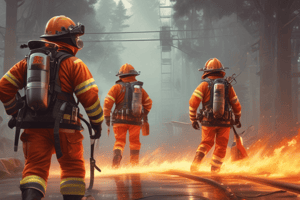Podcast
Questions and Answers
What is the recommended student-to-instructor ratio for effective live fire training?
What is the recommended student-to-instructor ratio for effective live fire training?
- 7:1
- 5:1 (correct)
- 10:1
- 3:1
Who should be the incident commander during live fire training?
Who should be the incident commander during live fire training?
- The logistics officer
- The operations officer
- The safety officer
- The instructor-in-charge (correct)
Which of the following is essential before conducting live fire training?
Which of the following is essential before conducting live fire training?
- Conducting a safety briefing (correct)
- Having a backup plan for emergencies
- Developing a detailed equipment list
- Meal breaks for all participants
What must not be used during live fire training?
What must not be used during live fire training?
What should participants understand about manikins used in training?
What should participants understand about manikins used in training?
What is the primary purpose of clear communication during training activities?
What is the primary purpose of clear communication during training activities?
How many high-risk topics should training focus on at one time?
How many high-risk topics should training focus on at one time?
What is the role of the safety officer in live fire training?
What is the role of the safety officer in live fire training?
What is a crucial component that must follow after training is conducted?
What is a crucial component that must follow after training is conducted?
Which position is responsible for managing logistics during live fire training?
Which position is responsible for managing logistics during live fire training?
Flashcards
Instructor Accountability
Instructor Accountability
Instructors are responsible for the safety and effectiveness of the training.
Student-to-Instructor Ratio
Student-to-Instructor Ratio
The optimal number of students for each instructor. Usually varies based on student experience and the complexity of training.
Incident Commander in Live Fire Training
Incident Commander in Live Fire Training
The instructor will serve as the person with ultimate control and responsibility during live fire sessions.
Safety Officer Role
Safety Officer Role
Signup and view all the flashcards
Live Victims Prohibited
Live Victims Prohibited
Signup and view all the flashcards
Training Manikins
Training Manikins
Signup and view all the flashcards
Safety Briefings
Safety Briefings
Signup and view all the flashcards
High-Risk Training Procedures
High-Risk Training Procedures
Signup and view all the flashcards
Incident Management System in Training
Incident Management System in Training
Signup and view all the flashcards
After-Action Review
After-Action Review
Signup and view all the flashcards
Study Notes
Fire Training Principles and Practice
- Instructors must consider the capabilities of the students, training complexity, and location size when determining student-to-instructor ratios (5:1 ratio generally required).
- Live fire training has specific safety protocols, particularly regarding instructor roles (e.g. incident commander, safety officer).
- A safety briefing prior to live fire training is mandatory, including identifying objectives, participants' roles, hazards, and expectations.
- High-risk training should focus on one topic per session, rather than multiple aspects.
- Using manikins for live fire training should involve participants' understanding of how manikins will be used and dressed, as well as their location, and appropriate highlighting.
- The use of live victims during live fire training is prohibited.
- Incident command structure should be used.
- A thorough plan with specific objectives is crucial for all training types.
- Clear communication is essential among instructors, support personnel, and students; this is important for a positive learning environment.
- An After-Action Review (AAR) should be conducted as part of training.
- Students and instructors must understand the purpose, goals, and activities involved in the training.
Studying That Suits You
Use AI to generate personalized quizzes and flashcards to suit your learning preferences.



